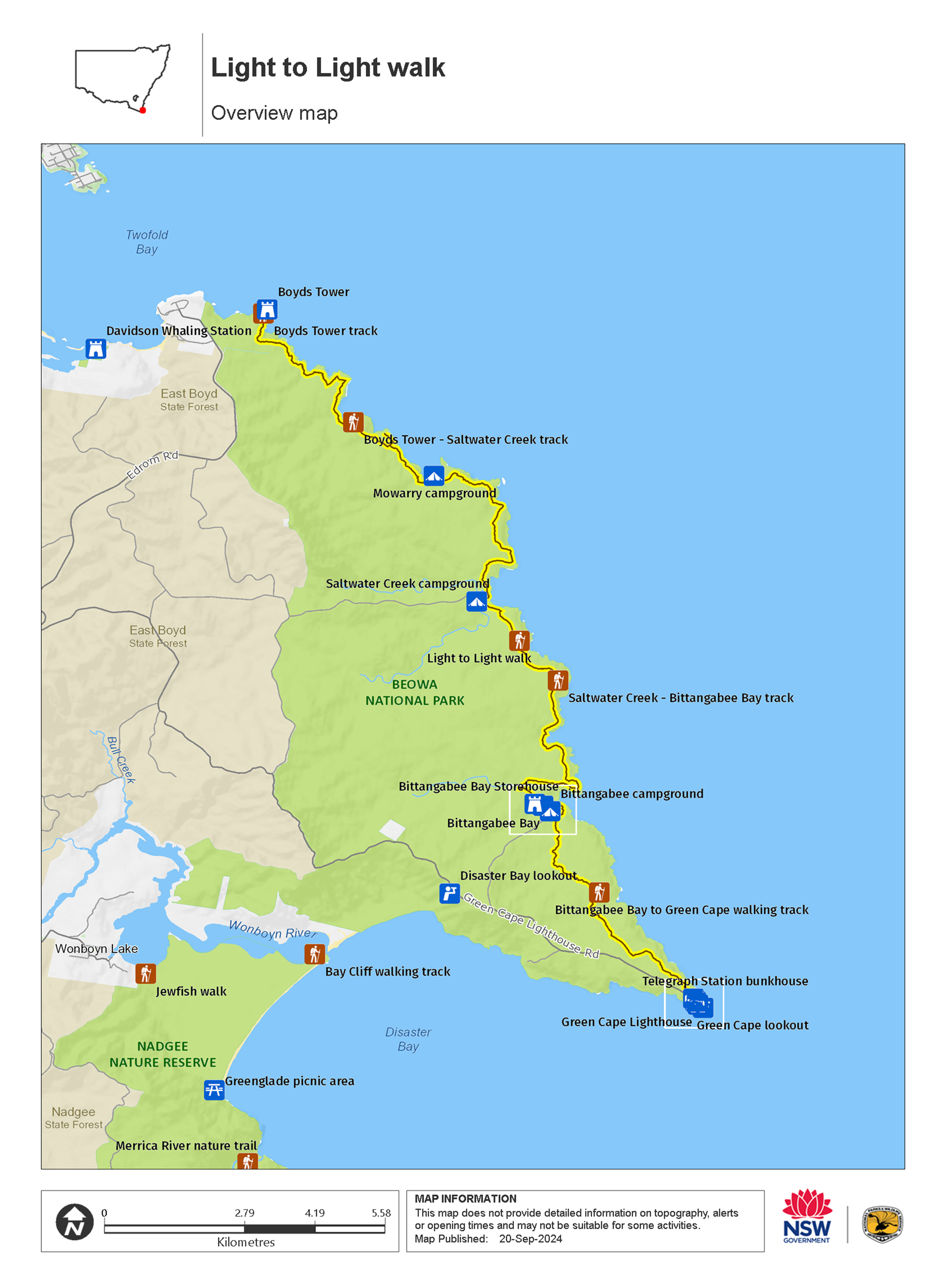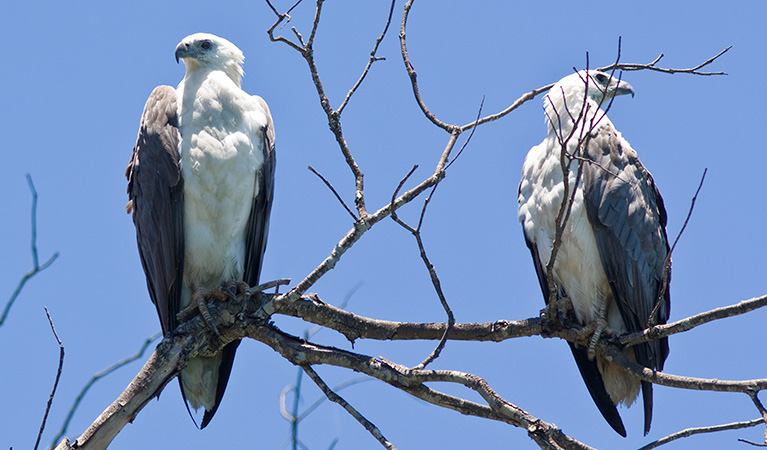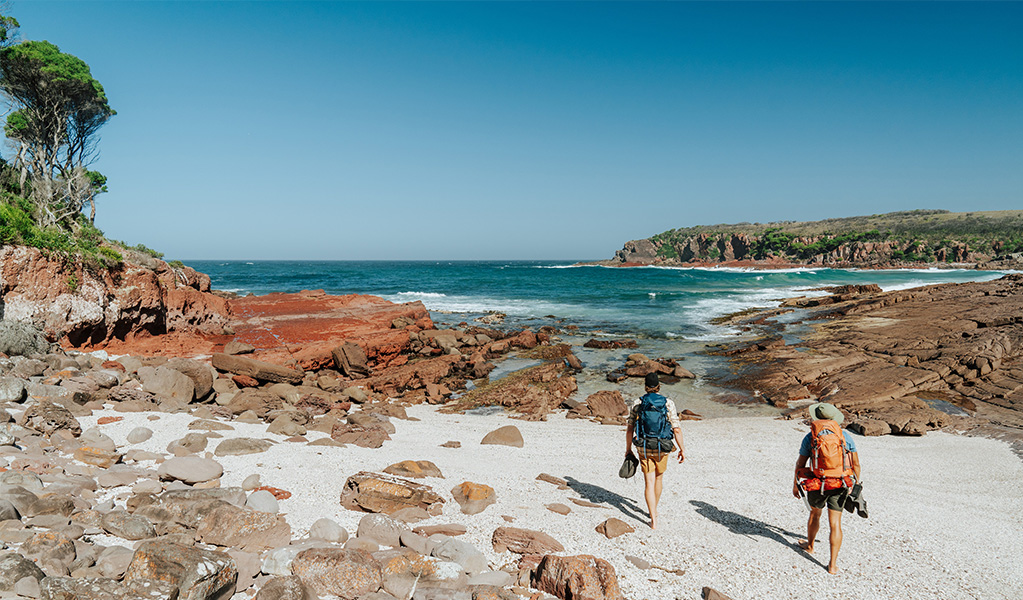Overview
Discover the wild beauty of the Far South Coast on the 32km Light to Light Walk, near Eden. Camp with views of the ocean at remote coastal campgrounds and end your walk at the southernmost lighthouse in NSW.
- Where
- Green Cape area in Beowa National Park in South Coast
- Distance
- 32km one-way
- Time suggested
- 2 - 3 days
- Grade
- Grade 4
- Trip Intention Form
-
It's a good idea to let someone know where you're going. Fill in a trip intention form to send important details about your trip to your emergency contact.
- Personal Locator Beacon
-
Hire a Personal Locator Beacon (PLB) for free at the Merimbula office.
- Entry fees
- Park entry fees apply
- What to
bring - Drinking water, food supplies, first aid kit, personal locator beacon, clothes for all weather conditions, sturdy shoes, hat, sunscreen, insect repellent
- Please note
- This walk can be done as a whole or in sections. If you choose to walk the track in sections, consider car pooling ahead of time.
- In some sections you’ll be crossing slippery rock platforms, cobbled beaches and shallow creeks.
- Water availability along the track is limited, so make sure you take water with you for drinking and cooking. Bring containers to carry at least 5L of water.
- While the track offers easy walking along a well-marked route, it does cover some remote country so it’s a good idea to bring a topographic map and compass, or a GPS
The Light to Light Walk hugs the coastline between historic Boyds Tower and Green Cape Lightstation. The views are stunning and ever-changing – from heathland to forest, tea tree groves to banksia woodlands, and sheltered coves to towering red rock platforms. Plus, with so many seafront vantage points, you can spot seals, seabirds and whales.
Enjoy a small section of the walk or embark on a self-guided multi-day hike, staying overnight at the hike-in campgrounds.
Detailed itinerary
Day 1: Boyds Tower to Mowarry Point
Distance: 9km
Time suggested: 2 to 3 hours
Toilets at: Boyds Tower, Mowarry campground
Water at: Boyds Tower, Mowarry campground
From Boyds Tower, follow the trail south and keep the coast on your left. Signposts will guide you as you meander through a coastal forest, reshaping and regrowing since the 2019/2020 fires.
Today you will get glimpses of the dramatic Devonian era geology that Beowa National Park is famous for. Leather Jacket Bay provides a great lunch or rest stop with plenty of shade and protection from the wind.
A few more undulating kilometres down the track will take you to Mowarry campground, the site of an old European settlement. Pitch your tent on one of 10 camping platforms, change into your swimming gear and rinse off in the sapphire blue waters of the bay.

Day 2: Mowarry Point to Hegartys Bay
Distance: 10km
Time suggested: 2.5 to 3.5 hours
Toilets at: Mowarry campground, Saltwater Creek campground, Hegartys Bay campground
Water at: Mowarry campground, Saltwater Creek campground, Hegartys Bay campground
Day 2 has a lot of diversity. Head across Mowarry Beach and back into the bush, traverse across heathlands and hop on and off rock shelves until you arrive at Saltwater Beach. Saltwater Creek and Woodburn Creek are intermittently open and closed to the ocean depending on the tide – you may need to get your feet wet when crossing these shallow creeks.
Poke your head into Saltwater Creek campground if you need to use the facilities. Drop toilets, rainwater tanks, barbecues and rubbish bins are available here.
Head south along Saltwater Beach until you find the rock steps with a short climb up onto the heathland, and keep your eyes peeled for the elusive eastern ground parrot. Get your first glimpses of Green Cape Lighthouse way off in the distance as you wind your way along the track and down into Hegartys Bay.
It’s just you and your fellow walkers at this quiet, walk-in campground at Hegartys Bay. Drop your pack at one of the camping platforms and go and explore the bay.

Day 3: Hegartys Bay to Green Cape Lighthouse
Distance: 13km
Time suggested: 3.5 to 4.5 hours
Toilets at: Hegartys Bay campground, Bittangabee campground, Pulpit Rock lookout
Water at: Hegartys Bay campground, Bittangabee campground
Wake up to catch the sunrise over the ocean while you eat breakfast on the beach. Pack up camp and meander through the heathland bursting with wildflowers before you reach Bittangabee Bay. Bittangabee Bay offers a range of swimming, snorkelling and side adventures, as well picnic tables, drop toilets, barbecues and a rainwater tank.
Pick up the new trail heading south along the rock shelf and look out for the unique Light to Light wayfinding markers. The next few kilometres of trail holds everything Beowa National Park has to offer – rock shelves, pebbly beaches, quiet places and breathtaking views.
Pulpit Rock offers sweeping vistas, a scenic midway point for a lunch break.
Explore the nooks and crannies of Beowa National Park as rock steps and staircases lead you on and off rock shelves, providing dramatic views over the Pacific Ocean. You’ll catch tantalising glimpses of Green Cape Lighthouse through the bush as you near the end of your 32km walk.
Finish your epic hike by walking out past the lighthouse onto Green Cape Lookout where 360 views of Beowa National Park, Nadgee Nature Reserve and Croajingalong National Park will have you dreaming of your next adventure.

Nearby
-

Green Cape Lighthouse
Green Cape Lighthouse, around 45min south of Eden, is the southernmost lighthouse in NSW. Towering above Green Cape Lightstation Keepers’ Cottages, soak up the maritime heritage and spot migrating whales.
-

Boyds Tower
Boyds Tower is the starting point of the Light to Light Walk. Near Eden, this accessible landmark tells the story of Benjamin Boyd who built the tower in 1847. Visit for some of the best whale watching on the NSW south coast.
Map

Map

Map

Map legend

Local alerts
For the latest updates on fires, closures and other alerts in this area, see https://www.nationalparks.nsw.gov.au/things-to-do/walking-tracks/light-to-light-walk-app/local-alerts
General enquiries
- National Parks Contact Centre
- 7am to 7pm daily
- 1300 072 757 (13000 PARKS) for the cost of a local call within Australia excluding mobiles
- parks.info@environment.nsw.gov.au
Park info
- in the Green Cape area of Beowa National Park in the South Coast region
The Green Cape area of Beowa National Park is always open but may have to close at times due to poor weather or fire danger.
-
$8 per vehicle per day in the Green Cape area of the park (south of Eden).
Buy annual pass.
Visitor info
All the practical information you need to know about Light to Light walk.
Track grading
Features of this track
Distance
32km one-way
Time
2 - 3 days
Quality of markings
Sign posted
Experience required
Experienced bushwalkers
Gradient
Short steep hills
Steps
Many steps
Quality of path
Rough track, many obstacles
Getting there and parking
Get driving directions
Boyds Tower is in the southern section of Beowa National Park. To get there:
- Travel south from Eden on the Princes Highway for 18km.
- Turn off at Edrom Road and follow it to the turn off near the end of the road.
Green Cape Lighthouse is also in the southern section of Beowa National Park. To get there:
- Travel south from Eden on The Princes Highway for 18km.
- Turn off at Edrom Road and follow it for 6km.
- Turn right onto unsealed Green Cape Road and follow it for 21km.
Take the hassle out of getting there and book a transfer with Navigate Expeditions. They offer specific pick-up and drop-off options in Merimbula and Eden, as well as flexible options to suit your travel arrangements.
Road quality
Check the conditions before setting out as some of the roads within the park can become boggy when it rains.
Vehicle access
- Most roads suitable for 2WD vehicles
Parking
Parking is available at a number of points along the track, including Boyds Tower, Green Cape Lighthouse, Saltwater Creek campground and Bittangabee campground.
Please note there are security risks with leaving your car overnight in this remote location. We recommend you book transfers with Navigate Expeditions or organise your own drop-off and pick-up.
Best times to visit
There are lots of great things waiting for you in Beowa National Park. Here are some of the highlights.
Autumn
Camp at Bittangabee Beach campground and see lyrebirds performing their characteristic dance and tail display.
Spring
Visit Green Cape Lighthouse or Boyds Tower to spot whales migrating south to their Antarctic feeding grounds - you might even see females with young calves.
Summer
Plan a camping trip to Saltwater Creek - to enjoy the lagoons and beautiful surf beach.
Winter
Take the Light to Light walk when it's nice and cool and the banksias are in bloom.
Facilities
There are 4 campgrounds located along this 32km walk. All have non-flush toilets and rainwater tanks.
There are small water tanks at Mowarry campground and Hegartys Bay campground but they don't provide a reliable supply of water. On days 2 and 3 you will pass by Saltwater Creek campground and Bittangabee campground where you can fill up on tank water with reliable supplies.
You must treat all water before drinking. Always boil water for at least 5mins before drinking or use treatment tablets, a filter or UV treatment.
Maps and downloads
Prohibited
Pets
Pets and domestic animals (other than certified assistance animals) are not permitted. Find out which regional parks allow dog walking and see the pets in parks policy for more information.
Smoking
NSW national parks are no smoking areas.
Learn more
Light to Light walk is in Green Cape area. Here are just some of the reasons why this park is special:
Aboriginal culture

The Yuin People are the Traditional Owners and Custodians of Beowa National Park and they have a long and complex relationship with the coastal environment. At Twofold Bay, the Yuin People had a special relationship with the orca whales. The orcas drove humpback whales into shore, the people used spears to kill them and the orcas and people shared the meat. Aboriginal people later taught European settlers to work with orca whales during the shore-based whaling days of Twofold Bay.
- Boyds Tower walking track Take an easy walk to historic Boyds Tower near Eden, find out about local history and marine animals, and enjoy whale watching from the lookouts.
Giants of the deep

Enjoy some of Australia’s best whale watching here between September and November when hundreds of whales and their calves move in to Twofold Bay to frolic and feed before migrating south to Antarctica. You can get a good view of Twofold Bay from the viewing platform at Boyds Tower. At the southern tip of the park, see if you can spot whales near Green Cape Lightstation or Disaster Bay lookout.
- Green Cape lookout Green Cape lookout in Beowa National Park is one of the best places to enjoy whale watching in NSW.
Rocks tell a story

Beowa’s stunning rock formations, inlets and headlands are the result of extensive geological folding. Most of the park lies on red, brown and green shales, sandstones, siltstones and quartzites. They were formed in the Devonian period around 360 million years ago—before dinosaurs roamed the earth. You can see these rock types exposed along the cliffs and headlands. The Devonian period is known as The Age of Fishes and internationally-significant fish fossils have been found in several places along the park’s coastline.
- Green Cape loop walking track Only 45 minutes from Eden in Beowa National Park, Green Cape loop walking track feels remote and wild. Its crashing seas, crimson rocks, bushland and wildlife will inspire all your senses.
- Light to Light Walk Discover the wild beauty of the Far South Coast on the 32km Light to Light Walk, near Eden. Camp with views of the ocean at remote coastal campgrounds and end your walk at the southernmost lighthouse in NSW.
Vulnerable species

The heathland in the Green Cape area of the park provides significant habitat for vulnerable species like the eastern ground parrot and striated fieldwren. It’s also a stronghold for NSW’s population of the endangered southern brown bandicoot. Around 50 native mammals and nearly 150 species of birds have been recorded in Beowa National Park, including 1 critically endangered bird, 4 endangered animal species and 25 vulnerable species.
- Boyds Tower Boyds Tower is the starting point of the Light to Light Walk. Near Eden, this accessible landmark tells the story of Benjamin Boyd who built the tower in 1847. Visit for some of the best whale watching on the NSW south coast.
- Boyds Tower walking track Take an easy walk to historic Boyds Tower near Eden, find out about local history and marine animals, and enjoy whale watching from the lookouts.
- Green Cape loop walking track Only 45 minutes from Eden in Beowa National Park, Green Cape loop walking track feels remote and wild. Its crashing seas, crimson rocks, bushland and wildlife will inspire all your senses.
- Light to Light Walk Discover the wild beauty of the Far South Coast on the 32km Light to Light Walk, near Eden. Camp with views of the ocean at remote coastal campgrounds and end your walk at the southernmost lighthouse in NSW.
Fascinating coastal heritage

The first shore-based whaling station on mainland Australia was set up at Twofold Bay in 1828. Benjamin Boyd established a competing business and built a private lighthouse, Boyd's Tower, and a township, Boydtown, before being declared bankrupt. The coast was the site of many shipwrecks. Green Cape Lighthstation started operation in 1883 but shipwrecks continued, including the Ly-ee-moon that sank in 1886. You can pay your respects to some of the 76 victims at a graveyard a short walk from the lighthouse. There are also regular guided tours of the lighthouse.
- Boyds Tower Boyds Tower is the starting point of the Light to Light Walk. Near Eden, this accessible landmark tells the story of Benjamin Boyd who built the tower in 1847. Visit for some of the best whale watching on the NSW south coast.
- Boyds Tower walking track Take an easy walk to historic Boyds Tower near Eden, find out about local history and marine animals, and enjoy whale watching from the lookouts.
- Green Cape Lighthouse guided tour Uncover the history of Green Cape Lighthouse on this guided tour in Beowa National Park, near Eden. Hear stories of disaster and survival and enjoy shore-based whale watching and breathtaking views.
Plants and animals protected in this park
Animals
-

Yellow-tailed black cockatoo (Calyptorhynchus funereus)
The yellow-tailed black cockatoo is one of the largest species of parrot. With dusty-black plumage, they have a yellow tail and cheek patch. They’re easily spotted while bird watching, as they feed on seeds in native forests and pine plantations.
-

White-bellied sea eagle (Haliaeetus leucogaster)
White-bellied sea eagles can be easily identified by their white tail and dark grey wings. These raptors are often spotted cruising the coastal breezes throughout Australia, and make for some scenic bird watching. Powerful Australian birds of prey, they are known to mate for life, and return each year to the same nest to breed.
-

Superb lyrebird (Menura novaehollandiae)
With a complex mimicking call and an elaborate courtship dance to match, the superb lyrebird is one of the most spectacular Australian animals. A bird watching must-see, the superb lyrebird can be found in rainforests and wet woodlands across eastern NSW and Victoria.
-

Eastern ground parrot (Pezoporus wallicus wallicus)
The eastern ground parrot is a beautiful, ground-dwelling native bird that lives in low heathland habitat along the NSW North and South coasts and escarpments. It’s listed as a vulnerable species in NSW.
-

Lace monitor (Varanus varius)
One of Australia’s largest lizards, the carnivorous tree-dwelling lace monitor, or tree goanna, can grow to 2m in length and is found in forests and coastal tablelands across eastern Australia. These Australian animals are typically dark blue in colour with whitish spots or blotches.
Plants
-

Black sheoak (Allocasuarina littoralis)
The black sheoak is one of a number of casuarina species found across the east coast of Australia and nearby tablelands. Growing to a height of 5-15m, these hardy Australian native plants can survive in poor or sandy soils. The barrel-shaped cone of the black sheoak grows to 10-30mm long.
-

Grey mangrove (Avicennia marina)
Grey mangrove is the most common and widespread mangrove found within intertidal zones across Australia, and throughout the world. Growing to a height of 3-10m, they thrive best in estuaries with a mix of fresh and salt water. They excrete excess salt through their long thick leaves, and absorb oxygen through their aerial root system.
-

Old man banksia (Banksia serrata)
Hardy Australian native plants, old man banksias can be found along the coast, and in the dry sclerophyll forests and sandstone mountain ranges of NSW. With roughened bark and gnarled limbs, they produce a distinctive cylindrical yellow-green banksia flower which blossoms from summer to early autumn.

